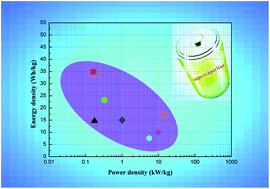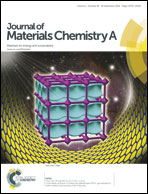NiCo2O4-based materials for electrochemical supercapacitors
Abstract
Nickel cobaltite (NiCo2O4), with excellent electrochemical performance, has become a new class of energy storage material for electrochemical supercapacitors, which facilitates to relieve the pressure of energy crisis and environmental pollution. It possesses richer electroactive sites and at least two magnitudes higher electrical conductivity than that of NiO and Co3O4, which exhibit not only large power density, but also high energy density of up to 35 W h kg−1. Furthermore, it shows comparable capacitive performances with noble metal oxides of RuO2, but with much lower cost and more abundant resources. This feature article briefly analyses the energy storage mechanism of NiCo2O4, summarizes the methodologies and nanostructures discovered in recent years, and points out the potential problems and future prospects of utilizing NiCo2O4-based materials as supercapacitor electrodes. Moreover, composite electrodes based on nickel cobaltite are also elaborated with considerable interest. Since the pioneering work of Hu and his group in 2010, numerous research studies have also demonstrated NiCo2O4 electrodes to show remarkable supercapacitive performances; however, more specialized work should be performed to further develop the potential of this novel electrode material so as to realize their massive commercial applications.

- This article is part of the themed collection: 2014 Journal of Materials Chemistry A Hot Articles

 Please wait while we load your content...
Please wait while we load your content...